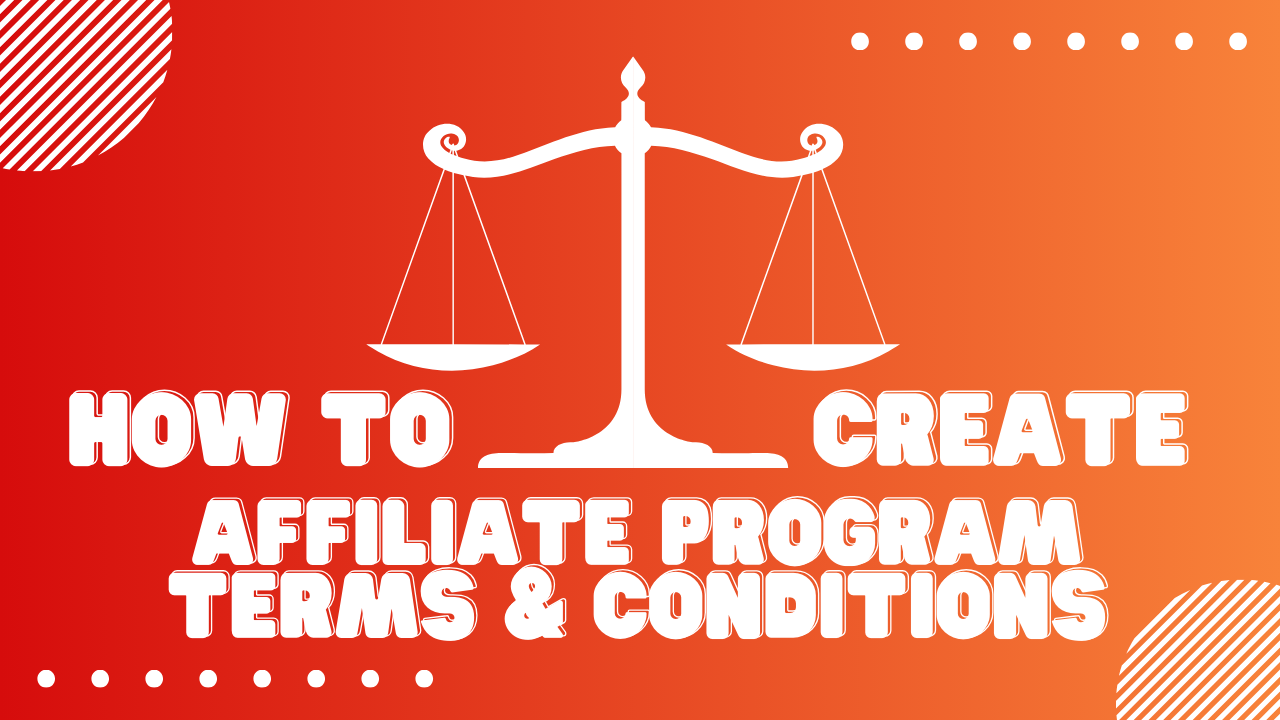If you’re stepping into the world of affiliate marketing, be aware: affiliate fraud is an unwelcome reality that’s growing. Concerned about how this might affect your program? That’s a valid worry. Today, we’re exploring the darker side of affiliate marketing—fraudulent activities that could significantly impact your operations. In this guide, I’ll help you recognize, prove, and address affiliate fraud effectively. Stay with us as I share the crucial steps to catch and prevent affiliate fraud and protect your business.

What the Heck is Affiliate Fraud?
Affiliate fraud might sound complex, but it boils down to one thing: affiliates breaking the rules to cheat the system. This deceitful activity encompasses any actions that violate the terms and conditions of an affiliate program. The impact? It costs companies and retailers millions by unfairly claiming commissions that don’t rightfully belong to the fraudsters. Affiliate fraud is essentially a form of corruption in marketing. It occurs when individuals use underhanded methods to trigger commission payouts they haven’t earned. These tactics could involve generating fake leads, or improperly claiming sales that they did not help to make. The ripple effects are damaging: legitimate affiliates lose out on earnings, businesses see a poor return on investment, and the overall brand reputation can suffer significant harm. Understanding the mechanics of affiliate fraud is crucial for anyone involved in affiliate marketing. Scammers might use sophisticated strategies to mimic legitimate affiliate activity, creating false impressions of traffic or sales that never occurred. This type of fraud not only skews performance metrics but also drains marketing budgets without delivering any real value.
Make sure that your affiliate program has a solid agreement (AKA Terms & Conditions). To make things simple, grab my template here!
How Common is Affiliate Fraud?
Affiliate fraud might seem like a shadow lurking in the corners of digital marketing, yet it’s not as prevalent as you might fear. While the allure of affiliate marketing grows, so does the temptation for fraudulent activities. However, it’s crucial to note that these instances are quite rare. But when they strike, they hit hard, potentially draining substantial funds from your business. Statistics paint a complex picture. Reports suggest that in some cases, up to 10% of affiliate traffic could be deceptive (Source). That number might sound alarming, but let’s put it into perspective. In my experience, the actual frequency of encountering such high levels of fraud is much lower. It’s important, though, to stay vigilant. The rise in affiliate fraud corresponds with the increasing attractiveness of affiliate programs as a revenue model. With each opportunity for legitimate affiliates to earn commissions, there’s an equivalent chance for scammers to exploit these systems. This makes affiliate programs prime targets for those looking to capitalize on the hard work of others. Despite this, the situation isn’t as dire as it might seem. Most affiliate marketers operate honestly, focusing on building genuine partnerships and driving real results. However, the small percentage that engages in fraudulent activities necessitates a proactive approach. Understanding the scale of affiliate fraud isn’t meant to deter you from starting or growing an affiliate program. Instead, it’s about preparation and protection. Knowing that the problem exists and recognizing its signs are your first steps toward safeguarding your interests. Next, I’ll guide you through spotting potential fraud and effectively managing these risks with minimal effort. Stay tuned as we explore the indicators of affiliate fraud and how to catch them early.
Monitoring for Affiliate Fraud (How Long Does it Take?)
 Monitoring for affiliate fraud is an ongoing necessity. Depending on the size of your affiliate program, the effort required to catch and prevent fraud will vary. Here’s a practical way to think about it: for every $100,000 in sales, you might spend about five minutes checking for discrepancies. This scales up as your sales increase. For instance, with $1 million in sales, expect to allocate around 50 minutes weekly to monitoring. The frequency of these checks can intensify as the stakes get higher. While the initial five minutes per $100,000 might hold up until you hit the half-million-dollar mark in sales, beyond this point, the time commitment can grow. Committing to at least ten minutes of fraud detection work for every $200,000 in revenue beyond the initial half-million can help in early detection and mitigation of potential fraud. For most businesses, a weekly check that lasts between thirty minutes to an hour is sufficient to stay ahead of fraudsters. These checks are vital for maintaining the integrity of your affiliate program and ensuring that every dollar spent on commissions is genuinely earned. In the following sections, we’ll dive deeper into the types of affiliate fraud you need to watch out for and discuss strategies for catching and preventing these deceptive practices. Knowing what to look for is the first step in protecting your affiliate program and ensuring its success.
Monitoring for affiliate fraud is an ongoing necessity. Depending on the size of your affiliate program, the effort required to catch and prevent fraud will vary. Here’s a practical way to think about it: for every $100,000 in sales, you might spend about five minutes checking for discrepancies. This scales up as your sales increase. For instance, with $1 million in sales, expect to allocate around 50 minutes weekly to monitoring. The frequency of these checks can intensify as the stakes get higher. While the initial five minutes per $100,000 might hold up until you hit the half-million-dollar mark in sales, beyond this point, the time commitment can grow. Committing to at least ten minutes of fraud detection work for every $200,000 in revenue beyond the initial half-million can help in early detection and mitigation of potential fraud. For most businesses, a weekly check that lasts between thirty minutes to an hour is sufficient to stay ahead of fraudsters. These checks are vital for maintaining the integrity of your affiliate program and ensuring that every dollar spent on commissions is genuinely earned. In the following sections, we’ll dive deeper into the types of affiliate fraud you need to watch out for and discuss strategies for catching and preventing these deceptive practices. Knowing what to look for is the first step in protecting your affiliate program and ensuring its success.
The Different Types of Affiliate Fraud
In the affiliate marketing world, fraud can manifest in various forms, each with its unique challenges and indicators. Understanding this is crucial for anyone running an affiliate program, as recognizing these types could be the key to safeguarding your operations. We’ll explore the most common types of affiliate fraud that businesses encounter today. From cookie stuffing to fake account creation, each method has its own set of red flags. Understanding these can help you not just catch fraudsters in the act but also prevent them from affecting your program in the first place. Keep reading as I break down each type of fraud, how to spot the signs, and the steps you can take to combat these deceptive tactics. This knowledge isn’t just about catching wrongdoing; it’s about creating a robust system that deters fraudsters long before they can cause harm.
1. Duplicating Content
 Content duplication is one of the simplest yet most effective methods fraudsters use to exploit affiliate programs. Essentially, these schemers take high-quality content from legitimate affiliate sites and replicate it on their own. By merely swapping out affiliate links, they divert commissions that rightfully belong to others. This form of fraud not only affects the rightful earnings of honest affiliates but also damages the integrity of your affiliate program. When duplicate content floods the market, it dilutes the uniqueness of your offers and can severely harm your SEO efforts, making it harder for potential customers to find the authentic sources. This can lead to a significant loss in both traffic and trust. For businesses, identifying and addressing this type of fraud is crucial. Regularly monitoring the web for duplicated content and using tools like Copyscape or Google’s search functions can help pinpoint where your affiliate content is being misused. Educating your affiliates about the importance of reporting suspicious activities can also foster a proactive community, vigilant against such deceptive practices.
Content duplication is one of the simplest yet most effective methods fraudsters use to exploit affiliate programs. Essentially, these schemers take high-quality content from legitimate affiliate sites and replicate it on their own. By merely swapping out affiliate links, they divert commissions that rightfully belong to others. This form of fraud not only affects the rightful earnings of honest affiliates but also damages the integrity of your affiliate program. When duplicate content floods the market, it dilutes the uniqueness of your offers and can severely harm your SEO efforts, making it harder for potential customers to find the authentic sources. This can lead to a significant loss in both traffic and trust. For businesses, identifying and addressing this type of fraud is crucial. Regularly monitoring the web for duplicated content and using tools like Copyscape or Google’s search functions can help pinpoint where your affiliate content is being misused. Educating your affiliates about the importance of reporting suspicious activities can also foster a proactive community, vigilant against such deceptive practices.
2. Cookie Stuffing
 Cookie stuffing is a deceptive tactic used by fraudulent affiliates to earn undeserved commissions. Essentially, it involves placing a tracking cookie on a user’s computer without their knowledge or consent. This is often done through questionable methods like hidden iframes, misleading links, or invisible images that automatically trigger the affiliate’s code when a page is loaded. This underhanded strategy leads to the affiliate getting credit for sales they did not help generate. Imagine a potential customer visiting various sites, including one infected by a cookie-stuffing scheme. Even if this customer later makes a purchase on your site through legitimate means, the fraudulent affiliate might still receive the commission, thanks to their unauthorized cookie in the customer’s browser. The harm extends beyond misdirected payouts. Cookie stuffing can skew your marketing data, leading to inaccurate metrics on affiliate performance. This not only affects budget allocation but also unfairly disadvantages honest affiliates who genuinely promote your products. Businesses must remain vigilant to prevent cookie stuffing. Regular audits of affiliate practices, employing stringent security measures on how cookies can be set, and educating affiliates about ethical practices are essential steps. Additionally, implementing advanced tracking solutions that can detect and disregard suspicious activities helps safeguard your program against such fraud. By staying proactive, companies can protect their interests and ensure a fair playing field for all affiliates. RELATED POST: Affiliate Management Q + A: Clicks, Commissions and Cookies
Cookie stuffing is a deceptive tactic used by fraudulent affiliates to earn undeserved commissions. Essentially, it involves placing a tracking cookie on a user’s computer without their knowledge or consent. This is often done through questionable methods like hidden iframes, misleading links, or invisible images that automatically trigger the affiliate’s code when a page is loaded. This underhanded strategy leads to the affiliate getting credit for sales they did not help generate. Imagine a potential customer visiting various sites, including one infected by a cookie-stuffing scheme. Even if this customer later makes a purchase on your site through legitimate means, the fraudulent affiliate might still receive the commission, thanks to their unauthorized cookie in the customer’s browser. The harm extends beyond misdirected payouts. Cookie stuffing can skew your marketing data, leading to inaccurate metrics on affiliate performance. This not only affects budget allocation but also unfairly disadvantages honest affiliates who genuinely promote your products. Businesses must remain vigilant to prevent cookie stuffing. Regular audits of affiliate practices, employing stringent security measures on how cookies can be set, and educating affiliates about ethical practices are essential steps. Additionally, implementing advanced tracking solutions that can detect and disregard suspicious activities helps safeguard your program against such fraud. By staying proactive, companies can protect their interests and ensure a fair playing field for all affiliates. RELATED POST: Affiliate Management Q + A: Clicks, Commissions and Cookies
3. Spyware
 Spyware is a sinister tool in affiliate fraud, where deceptive software is installed on a user’s device without their consent. This software manipulates user activities by inserting or altering affiliate tracking codes. Essentially, it can redirect commissions to the fraudster when the user makes purchases online. Often hidden in downloads like browser toolbars or ad pop-ups, spyware can mislead even legitimate customers into generating revenue for a scammer. This not only violates privacy but also distorts true sales data and unfairly diverts earnings from rightful affiliates. This is one area where we have a zero-tolerance policy. Affiliates must adhere to strict guidelines that outlaw the use of such deceptive practices. By maintaining clear, enforced rules against spyware, businesses can safeguard their affiliate programs and ensure a fair competitive environment.
Spyware is a sinister tool in affiliate fraud, where deceptive software is installed on a user’s device without their consent. This software manipulates user activities by inserting or altering affiliate tracking codes. Essentially, it can redirect commissions to the fraudster when the user makes purchases online. Often hidden in downloads like browser toolbars or ad pop-ups, spyware can mislead even legitimate customers into generating revenue for a scammer. This not only violates privacy but also distorts true sales data and unfairly diverts earnings from rightful affiliates. This is one area where we have a zero-tolerance policy. Affiliates must adhere to strict guidelines that outlaw the use of such deceptive practices. By maintaining clear, enforced rules against spyware, businesses can safeguard their affiliate programs and ensure a fair competitive environment.
4. Fake Discount Codes
 Fake discount codes are a sly tactic used by some affiliates to trick potential customers into clicking their affiliate links. This kind of fraud begins when a user searches for discount codes for specific products or services. The deceptive affiliate sets up a site or an ad claiming to offer these discounts. When users click on these supposed discount links, they don’t actually receive any discount because, in many cases, the product doesn’t even have a discount code available. What happens next is particularly cunning. The user, having clicked the link in hope of a discount, has unknowingly activated the affiliate’s cookie. Even if they realize the code is fake and decide to purchase at full price, the transaction gets credited to the fraudulent affiliate due to the cookie tracking their last click. This scenario not only misleads the customer but also unjustly rewards the affiliate. Establishing clear guidelines and consequences for discount codes within the affiliate agreement is crucial to discourage such deceitful practices.
Fake discount codes are a sly tactic used by some affiliates to trick potential customers into clicking their affiliate links. This kind of fraud begins when a user searches for discount codes for specific products or services. The deceptive affiliate sets up a site or an ad claiming to offer these discounts. When users click on these supposed discount links, they don’t actually receive any discount because, in many cases, the product doesn’t even have a discount code available. What happens next is particularly cunning. The user, having clicked the link in hope of a discount, has unknowingly activated the affiliate’s cookie. Even if they realize the code is fake and decide to purchase at full price, the transaction gets credited to the fraudulent affiliate due to the cookie tracking their last click. This scenario not only misleads the customer but also unjustly rewards the affiliate. Establishing clear guidelines and consequences for discount codes within the affiliate agreement is crucial to discourage such deceitful practices.
5. Typo Squatting / URL Hijacking
 Typo squatting (AKA URL hijacking) is a fraud tactic where fraudsters purchase domain names that are misspellings of popular brands. This form of affiliate fraud preys on accidental typos made by internet users trying to visit a specific website. For instance, if someone mistakenly types ‘noprodutcnoproblem.com’ instead of ‘noproductnoproblem.com‘, they might land on a fraudulent site for my No Product No Problem course without realizing it. Once on the mimicked site, the user may click on a link that seems legitimate but is actually rigged. The click triggers an affiliate link, redirecting them to the real website where they complete their purchase. Unbeknownst to them, the commission for their purchase goes to the scammer, not the legitimate affiliate. Businesses can protect their brands and customers by monitoring for domain registrations closely resembling their own and educating customers about correct URLs. Affiliate managers should also be vigilant in screening and approving affiliates to prevent those with dubious practices from joining their programs.
Typo squatting (AKA URL hijacking) is a fraud tactic where fraudsters purchase domain names that are misspellings of popular brands. This form of affiliate fraud preys on accidental typos made by internet users trying to visit a specific website. For instance, if someone mistakenly types ‘noprodutcnoproblem.com’ instead of ‘noproductnoproblem.com‘, they might land on a fraudulent site for my No Product No Problem course without realizing it. Once on the mimicked site, the user may click on a link that seems legitimate but is actually rigged. The click triggers an affiliate link, redirecting them to the real website where they complete their purchase. Unbeknownst to them, the commission for their purchase goes to the scammer, not the legitimate affiliate. Businesses can protect their brands and customers by monitoring for domain registrations closely resembling their own and educating customers about correct URLs. Affiliate managers should also be vigilant in screening and approving affiliates to prevent those with dubious practices from joining their programs.
6. Ad Stacking
 Ad stacking is a type of affiliate fraud where multiple advertisements are layered on top of one another within the same ad space. While only the top ad is visible and clickable, all underlying ads register impressions or clicks that they don’t legitimately deserve. This not only distorts engagement metrics but also unjustly increases costs for advertisers. This fraudulent tactic is often executed using sophisticated scripts or bots that can simulate user interactions, making it challenging to detect. For affiliate programs, this means that they could be paying commissions on traffic that has never genuinely engaged with their ads. Detecting ad stacking typically involves analyzing traffic patterns for anomalies such as unexpectedly high click rates or abnormal patterns of user behavior, which could indicate automated interactions. To combat ad stacking effectively, businesses need to implement rigorous monitoring of their ad placements. Utilizing advanced fraud detection tools that can identify irregularities in ad performance is crucial. Additionally, maintaining transparent relationships with affiliates and conducting regular audits of affiliate activities can help in identifying and addressing this issue proactively.
Ad stacking is a type of affiliate fraud where multiple advertisements are layered on top of one another within the same ad space. While only the top ad is visible and clickable, all underlying ads register impressions or clicks that they don’t legitimately deserve. This not only distorts engagement metrics but also unjustly increases costs for advertisers. This fraudulent tactic is often executed using sophisticated scripts or bots that can simulate user interactions, making it challenging to detect. For affiliate programs, this means that they could be paying commissions on traffic that has never genuinely engaged with their ads. Detecting ad stacking typically involves analyzing traffic patterns for anomalies such as unexpectedly high click rates or abnormal patterns of user behavior, which could indicate automated interactions. To combat ad stacking effectively, businesses need to implement rigorous monitoring of their ad placements. Utilizing advanced fraud detection tools that can identify irregularities in ad performance is crucial. Additionally, maintaining transparent relationships with affiliates and conducting regular audits of affiliate activities can help in identifying and addressing this issue proactively.
7. Stolen Data
 Stolen data represents one of the most severe types of affiliate fraud, crossing the line into outright criminal activity. This form of fraud involves affiliates who acquire stolen credit card details or personal information to falsely generate sales or leads, aiming solely to earn commissions. These unscrupulous affiliates are not interested in the products but are exploiting the system to siphon off affiliate commissions. When affiliates use stolen data to make purchases, these transactions may initially appear legitimate, boosting perceived sales and commissions. However, once the theft is discovered, these purchases lead to chargebacks from credit card companies. This not only costs the merchant in refunded sales but also in additional chargeback fees, which can accumulate and significantly impact financial stability. The challenge with stolen data in affiliate marketing is its sophistication and difficulty to trace. Fraudulent affiliates often use advanced techniques and proxy servers to mask their activities, making detection and prevention challenging. To combat this, businesses must enhance their security measures. Implementing strict verification processes for new affiliates, monitoring transaction patterns for irregularities, and using advanced fraud detection software are essential steps in protecting against stolen data.
Stolen data represents one of the most severe types of affiliate fraud, crossing the line into outright criminal activity. This form of fraud involves affiliates who acquire stolen credit card details or personal information to falsely generate sales or leads, aiming solely to earn commissions. These unscrupulous affiliates are not interested in the products but are exploiting the system to siphon off affiliate commissions. When affiliates use stolen data to make purchases, these transactions may initially appear legitimate, boosting perceived sales and commissions. However, once the theft is discovered, these purchases lead to chargebacks from credit card companies. This not only costs the merchant in refunded sales but also in additional chargeback fees, which can accumulate and significantly impact financial stability. The challenge with stolen data in affiliate marketing is its sophistication and difficulty to trace. Fraudulent affiliates often use advanced techniques and proxy servers to mask their activities, making detection and prevention challenging. To combat this, businesses must enhance their security measures. Implementing strict verification processes for new affiliates, monitoring transaction patterns for irregularities, and using advanced fraud detection software are essential steps in protecting against stolen data.
8. Fake Calls (Pay Per Call)
 Fake calls are a deceptive tactic in affiliate marketing, particularly within programs that operate on a Pay-per-call basis. This type of fraud occurs when affiliates set up sham scenarios to generate unearned commissions by exploiting the pay-per-call system. A common method involves posting fictitious job ads on platforms like Craigslist, where they lure unsuspecting job seekers into making phone calls under the guise of a job screening process. The trick is simple yet cunning. Affiliates instruct these job seekers to call a specific number—purporting it to be part of the interview process—and maintain the conversation for a set duration, often at least three minutes. The callers believe they are making a legitimate inquiry or undergoing a pre-interview assessment, but in reality, there is no job. The affiliate, however, collects a commission for each call, exploiting these individuals’ efforts and the company’s resources. Such practices not only lead to financial losses for companies but also tarnish their reputation with fake interactions. To counter this, businesses must implement stringent monitoring tools to detect unusual patterns in call durations and origins, and verify the legitimacy of calls linked to affiliate commissions. Establishing strict guidelines and quick response mechanisms for flagged activities can also help mitigate the risk of falling victim to this form of affiliate fraud.
Fake calls are a deceptive tactic in affiliate marketing, particularly within programs that operate on a Pay-per-call basis. This type of fraud occurs when affiliates set up sham scenarios to generate unearned commissions by exploiting the pay-per-call system. A common method involves posting fictitious job ads on platforms like Craigslist, where they lure unsuspecting job seekers into making phone calls under the guise of a job screening process. The trick is simple yet cunning. Affiliates instruct these job seekers to call a specific number—purporting it to be part of the interview process—and maintain the conversation for a set duration, often at least three minutes. The callers believe they are making a legitimate inquiry or undergoing a pre-interview assessment, but in reality, there is no job. The affiliate, however, collects a commission for each call, exploiting these individuals’ efforts and the company’s resources. Such practices not only lead to financial losses for companies but also tarnish their reputation with fake interactions. To counter this, businesses must implement stringent monitoring tools to detect unusual patterns in call durations and origins, and verify the legitimacy of calls linked to affiliate commissions. Establishing strict guidelines and quick response mechanisms for flagged activities can also help mitigate the risk of falling victim to this form of affiliate fraud.
9. Trademark Bidding
 Trademark bidding occurs when affiliates bid on your brand’s PPC keywords, a practice that may or may not be allowed depending on your affiliate program’s rules. As the program owner, the decision to permit this lies with you. While there are arguments against allowing it due to potential fraud, sometimes it could be beneficial. See below where I get in more depth on whether you should allow trademark bidding or not. Brand bidding can seem like a clever strategy for affiliates to leverage your brand’s reputation to boost their own commissions. This type of fraud involves using your business’s brand name in paid search ads to redirect traffic to their sites or affiliate programs, often leading to false attributions and undue commissions. Such actions not only misuse your brand but can also inflate your cost-per-click (CPC), making your keywords pricier. To defend against trademark bidding, proactive monitoring of your paid search campaigns is essential. Here are practical steps to safeguard your brand: Bid on Your Keywords: Actively bidding on your own brand keywords can prevent affiliates from capitalizing on your reputation and ensures your ads maintain top visibility. Monitor Campaigns Vigilantly: Keep an eye on ad copy, targeting settings, and the analytics of clicks and conversions to spot any irregular activities. Geotargeting tricks are often used by affiliates to hide their fraudulent activities from detection. For example, if an affiliate knows where the program manager is based (in my case, Fort Wayne, Indiana), they might exclude ads from appearing in that region. They won’t run ads from Illinois, Michigan, Indiana, or Ohio to avoid me catching them. The solution to this is to change your location. I’ll change my location to another state far away and other countries to see if anyone is bidding on our keywords. There are also automated tools that accomplish this same thing. If an affiliate is found exploiting your brand outside your geographic area, immediate action can be taken, including termination from the program.
Trademark bidding occurs when affiliates bid on your brand’s PPC keywords, a practice that may or may not be allowed depending on your affiliate program’s rules. As the program owner, the decision to permit this lies with you. While there are arguments against allowing it due to potential fraud, sometimes it could be beneficial. See below where I get in more depth on whether you should allow trademark bidding or not. Brand bidding can seem like a clever strategy for affiliates to leverage your brand’s reputation to boost their own commissions. This type of fraud involves using your business’s brand name in paid search ads to redirect traffic to their sites or affiliate programs, often leading to false attributions and undue commissions. Such actions not only misuse your brand but can also inflate your cost-per-click (CPC), making your keywords pricier. To defend against trademark bidding, proactive monitoring of your paid search campaigns is essential. Here are practical steps to safeguard your brand: Bid on Your Keywords: Actively bidding on your own brand keywords can prevent affiliates from capitalizing on your reputation and ensures your ads maintain top visibility. Monitor Campaigns Vigilantly: Keep an eye on ad copy, targeting settings, and the analytics of clicks and conversions to spot any irregular activities. Geotargeting tricks are often used by affiliates to hide their fraudulent activities from detection. For example, if an affiliate knows where the program manager is based (in my case, Fort Wayne, Indiana), they might exclude ads from appearing in that region. They won’t run ads from Illinois, Michigan, Indiana, or Ohio to avoid me catching them. The solution to this is to change your location. I’ll change my location to another state far away and other countries to see if anyone is bidding on our keywords. There are also automated tools that accomplish this same thing. If an affiliate is found exploiting your brand outside your geographic area, immediate action can be taken, including termination from the program.
Should You Allow Trademark Bidding?
At the risk of getting off-topic, this is an important question. In my post on creating an affiliate program agreement (AKA Terms and Conditions), I share my thoughts on trademark bidding. If you really want to know everything about trademark bidding and PPC (Pay-Per-Click) policies, read that post.  Here is an excerpt of the post most relevant to affiliate fraud.
Here is an excerpt of the post most relevant to affiliate fraud.
Trademark bidding, simply put, is affiliates who bid on branded search terms. For instance, these paid search ads may contain your brand’s name alone or include modifiers like “reviews” or “promo code,” often referred to as “Trademark Plus” or “TM+.”
Before you dismiss this as a completely bad idea, there are legitimate reasons to allow trademark bidding by affiliates, such as:
1. Defensive Coverage Against Competitors
Allowing your affiliates to run ads with your trademark terms can be a smart move. It’s akin to fortifying your brand’s online presence. This strategy can push competitors off the page, effectively safeguarding your potential customers from being lured away.
2. Extra Real Estate on Search Results
Google typically permits only one ad per domain. By partnering with affiliate marketers, you increase the likelihood of potential customers finding your brand instead of competitors. This expanded real estate on search results translates to more visibility.
3. Message Control
When affiliates bid on your trademark terms, you retain the final say on their ad content. This level of control ensures that their messaging aligns with your brand’s ethos, enhancing brand consistency and customer trust.
4. Additional Exposure and Benefits
By allowing your affiliates to bid on your trademark terms, you open doors to potential benefits like media subsidy packages. These packages can provide your brand with extra exposure without hefty upfront costs, thanks to your affiliate’s marketing efforts.
So, should your affiliate program allow trademark bidding or not? Ultimately, it depends on a few factors. Here’s who stands to benefit the most from trademark bidding affiliate partnerships:
Brands in Competitive Industries
Highly competitive industries often witness aggressive tactics by competitors. Allowing affiliates to bid on your trademarks can be a savvy defensive move.
Brands with Strong Reseller Presence
If you prefer customers to buy directly from you rather than through resellers, trademark bidding with affiliate partners can redirect potential customers to your brand.
Brands with Limited Budgets
If you have budget constraints for search or affiliate marketing, leveraging affiliate partners for trademark bidding can help you extend your reach effectively.
Incorporating trademark bidding into your affiliate program terms and conditions can open new avenues for enhancing your brand’s online presence and safeguarding your market share.
The question to ask yourself here is how popular is your brand and what are people saying about it online?
If you have a huge brand with hundreds of positive reviews, you have no need for affiliates bidding on your trademark keywords. If you do not, you may wish to allow it.
2. You may not use our trademarked terms as part of the name of your site (e.g., you cannot name your site “ Coupons”).
This is pretty straightforward. If you do allow trademark bidding, you will definitely want to disallow affiliates from using your name as a part of their site name.
3. You may not use our trademarked terms in your ad title, ad copy, display name or as the display url.
Again, this helps avoid any brand confusion and avoids affiliates posing as your actual company.
4. You may not direct link to our website from any Pay Per Click ad or use redirects that yield the same result. Affiliates must be directed to an actual page on your website.
This requires them to send traffic to a bridge page on the affiliate’s site, rather than directly to yours. Again, this helps eliminate any confusion about who is running the ads.
If you automate your PPC campaigns, it is your responsibility to exclude our trademarked terms from your program and we strongly suggest you add our trademarked terms as negative keywords. We have a strict no tolerance policy on PPC trademark bidding. You will forfeit all commissions for a minimum of the past 30 days and your commission will be set to 0% without warning if you engage in PPC trademark bidding that uses our trademarked terms.
This section puts an additional onus on the affiliate to protect your brand.
A “negative keyword” is a term that you specify to instruct search engines not to display your ad for searches containing that particular keyword. In other words, if your company name is “Acme Shoe Polish” and an affiliate bids on “shoe polish,” a search for “Acme Shoe Polish” will show their ad. But if they add “Acme” as a negative keyword, it will not.
Trademarked Terms:
Clearly list all relevant trademark terms they must avoid bidding on. You may wish to include any personalities’ names as well (such as the owner of the company or face of the company). Also, make sure to include any product names you do not wish affiliates to bid on.
This clearly lays out the rules and if someone breaks the rules, the punishments are also clear.
How to Catch Affiliate Fraud
 So now that you know what affiliate fraud is and what the different types look like, what are the indicators of affiliate fraud? What should you actually be looking for? Here are some of the leading indicators we use in our agency to spot fraud quickly and stop it in its tracks.
So now that you know what affiliate fraud is and what the different types look like, what are the indicators of affiliate fraud? What should you actually be looking for? Here are some of the leading indicators we use in our agency to spot fraud quickly and stop it in its tracks.
Unusually High or Low Conversion Rates
One of the most telling signs of potential fraud in affiliate marketing is unusual conversion rates, whether they’re too high or too low: High Click-to-Lead Conversion Rates: A typical scenario might involve a high number of leads compared to clicks, such as 496 leads from 500 clicks. This disparity could indicate fraudulent activities where an affiliate uses deceptive tactics to generate leads. Low Click-to-Lead Conversion Rates: Conversely, extremely low conversions, like two leads from 500 clicks, might also signal problems. This could be a sign of poor traffic quality or intentional misreporting to manipulate campaign data. High Lead-to-Sales Conversion Rates: An affiliate showing a dramatically high sales conversion rate compared to the average could be manipulating their results. For example, converting 70 out of 200 leads could be suspicious unless there’s a credible explanation, like targeting a highly engaged, niche audience. Low Lead-to-Sales Conversion Rates: While less common, significantly low sales rates can also be problematic, suggesting the affiliate might be inflating lead numbers without genuine conversion intent.
Patterns of Clicks: Floods Followed by Droughts
My friend Jeannine Crooks from ShareASale shared an interesting pattern: affiliates showing sporadic bursts of activity followed by silence.
“On one program, a certain affiliate seemed to be consistently performing at a small but steady level. However, upon reviewing the daily timing of his activity, it turned out that he was hand-entering the leads into our program and our competitor’s programs as well. To keep his conversion rate realistic, he generated clicks during his coffee breaks while working his day job.”
Sudden Emergence as a Top Performer
If an affiliate suddenly rises to the top of your sales leaderboard without a prior history or visibility in the program, this deserves scrutiny. Their sudden success might be legitimate, due to effective marketing strategies or promotions, but it could also be a result of deceptive practices like using unauthorized promotional methods or spamming.
High Refund Rates and Chargebacks
A high refund rate significantly above the program average is a red flag. If an affiliate’s refund rate exceeds 15%, when your average is around 5%, it’s crucial to investigate the quality of the sales they are generating. High chargebacks might also indicate the use of stolen credit card information or dissatisfaction due to misleading promotion tactics.
Complaints and Feedback
Credit Card Fraud: Be especially cautious with new affiliates who quickly incur credit card fraud complaints. Investigating their sales thoroughly can help determine if there’s a pattern of fraudulent behavior. Spam Complaints: Receiving spam complaints linked to an affiliate’s promotional methods is a serious concern. While not always grounds for immediate dismissal, it necessitates a closer examination of their practices to ensure compliance with your program’s guidelines. These are by far the most common indicators of affiliate fraud, but of course fraudulent affiliates are getting more sophisticated, so there will likely be more indicators in the future.
Don’t make the same mistakes I’ve made with my affiliate programs. Learn my top 20 affiliate program mistakes…and how to avoid them!
Additional Indicators to Look For
Once you’ve identified the obvious signs of potential affiliate fraud, we want to dig a little further. The following is a comprehensive list of all the things we check for when looking at potential fraud.
Lack of Communication
If an affiliate rarely or never contacts you, it could indicate they’re trying to fly under the radar. Scammers don’t typically reach out to the affiliate manager very much. While not definitive proof of fraud, it’s a red flag that warrants closer monitoring.
Traffic and Click Patterns
Always the Last Click: If an affiliate consistently appears as the last click but never the first, it could indicate manipulation, such as cookie stuffing or the use of iframes. This pattern, especially when repeated across many transactions, is usually a strong reason for removal. Irregular Sales Page Visit Duration: Extremely short or long visit durations compared to the norm can suggest that the traffic is not genuine. If an affiliate’s traffic consistently shows unusual time spent on pages, it’s worth investigating further.
Technical Footprints
Repeated IP Addresses: Multiple purchases from the same IP address can indicate that a single entity is manipulating the sales. This situation often calls for immediate action if the pattern is clear and repetitive. Email Metrics: Extremely low or near-100% open rates and high bounce rates are indicators of poor quality or fraudulent leads. Such anomalies should prompt a review of the affiliate’s methods and potentially their removal if fraud is confirmed.
Conversion and Sales Anomalies
Unusual Conversion Rates: Significantly higher or lower conversion rates than average can indicate deceptive practices. These should be scrutinized, and if no reasonable explanation is found, termination might be necessary. Event Attendance Rates: If none of an affiliate’s referred leads attend scheduled webinars or workshops, it questions the legitimacy of those leads. Low participation rates compared to other affiliates is a concern that needs addressing.
Behavioral Patterns
One-Route Buyers: If all sales from an affiliate come exclusively from one source (e.g., only from a sales page, but not from live events or webinars), it may suggest manipulative tactics or non-genuine traffic. Patterns in Sign-ups: Uniformity in email addresses or names, such as sequential or formulaic naming, can be a sign of automated or fake registrations. This pattern often merits a deeper investigation or even removal from the program. I once caught an affiliate submitting fraudulent leads solely on the basis of every one of this leads’ email addresses being in the same format (first initial, last name @ gmail.com, such as jsmith, tanderson, etc.).
To Remove or Not to Remove?
Once you’ve identified potential signs of affiliate fraud, the big question remains: Should you remove the affiliate from your program? This decision can be complex, depending on the nature and severity of the fraud. Below, I’ll share whether or not specific situations warrant removing an affiliate or just warning them. Think of it as red flags and yellow flags. A red flag is an immediate removal, with no warning. The affiliate knew they were breaking the rules and did so intentionally. A yellow flag is when there might be some nuance. 🚩 Duplicating Content There is simply no way to duplicate content unintentionally. This is always a red flag and warrants removal. 🚩 Cookie Stuffing There is no way to accidentally do this. Another easy decision. ⚠️ Spyware Most of the time, spyware directly violates the terms of the affiliate agreement. BUT…and this is a big but (pardon the juvenile giggles), sometimes it’s possible to market on a platform that uses spyware unbeknownst to the affiliate. So this is a yellow flag but ultimately up to the affiliate manager. This is situationally specific and usually warrants reaching out the affiliate to ask what the heck is going on. Their response will determine the next steps. 🚩 Fake Discount Codes Anyone using fake discount codes knows what they are doing. This is a direct violation of a good affiliate agreement and warrants immediate removal. 🚩 Typo Squatting / URL Hijacking Presuming that your affiliate program agreement prohibits this, the affiliate knows they are breaking the rules and this is a red flag. Instant removal. 🚩 Ad Stacking Again, there is no way to accidentally do this. It is 100% intentional and the objective to is cheat the system. 🚩 Stolen Data Do I even need to address this one? The only question here is if you will need to involve law enforcement or not. 🚩 Fake Calls This is a blatant red flag if you can prove that the affiliate is generating truly fake calls. If you record inbound calls (which is the norm), you have easy access to these calls to see what people are saying. ⚠️ Trademark Bidding This one is the trickiest of them all. Some programs actually allow unrestricted trademark bidding, so it’s not fraud in any way. Others allow zero trademark bidding, while others allow restricted bidding. Ultimately, this is up to the affiliate manager. If you have to protect a big brand at all costs and your affiliate program terms are clear about trademark bidding, it might be an easy decision. If your terms are murky at best, tread carefully. It usually depends on the level of egregiousness in the violation. I used to work for Legacy Learning Systems and one of our courses was “Learn and Master Guitar.” We did not allow trademark bidding but what if someone was bidding on “learn guitar.” That is not a trademark violation at all. So we would tell them to make sure they use a negative keyword for “master” when they bid on “learn guitar.” So if someone searches for our exact name, their ad won’t show up. That’s education, not removal. On the other hand, if someone is knowingly bidding on our trademark terms and geotargeting to avoid my location, I will kick them out in a heartbeat. Ultimately, the decision to remove an affiliate should be based on a combination of these indicators, backed by solid evidence. Being proactive in detecting and addressing affiliate fraud not only protects your program but also maintains the integrity of your marketing efforts.
Documenting Affiliate Fraud
 Documenting any incidents of affiliate fraud is crucial for legal protection and maintaining the integrity of your program. Here’s how to systematically document affiliate fraud effectively:
Documenting any incidents of affiliate fraud is crucial for legal protection and maintaining the integrity of your program. Here’s how to systematically document affiliate fraud effectively:
Gather Evidence
Start by collecting all possible evidence of fraudulent activity. This includes: Screenshots: Capture any suspicious activity, such as unexpected ad placements, strange affiliate performance metrics, or proof of trademark bidding. Tracking Reports: Use reports from your affiliate tracking software to identify anomalies in traffic patterns, conversion rates, or payout amounts. Communication Records: Keep a record of all communications with the suspected affiliate. Opt for written forms of communication like emails or texts, which can be easily documented and referred back to.
Detailed Record-Keeping
Maintain detailed records of all findings. This should include: Date and Time: Note when the fraudulent activity was discovered and any relevant timestamps from your tracking tools. Affiliate Information: Document the affiliate’s ID, the nature of their agreement with you, and any past issues. Incident Description: Write a clear description of the suspected fraud, explaining how it deviates from normal activity or breaches your affiliate agreement.
Verifying Incidents
Before taking action: Verify Purchases: Contact customers who made purchases through the suspicious affiliate. Confirm their purchase intent and inquire whether they were aware of being referred by the affiliate. Analyze Behavioral Patterns: Look for unusual patterns like consistent last-minute clicks, high refund rates, or geographic discrepancies in sales data. I wrote extensively about this above.
Communication and Action
Once you have gathered sufficient evidence: Notify the Affiliate: Inform the affiliate in question about the issue. Provide them with the evidence and explain why their actions are problematic. Demand Corrective Actions: Request the affiliate to cease the fraudulent activities. Specify actions they need to take, such as removing unauthorized ads or ceasing to use forbidden promotional methods. Follow-Up: Monitor the affiliate’s compliance with your requests. Keep documenting any further interactions or continued fraudulent activity.
Legal Safeguards
Documentation: Keep all documentation organized and accessible. This includes saving digital copies of all evidence and communications. Legal Advice: Consult with legal counsel if the fraud is extensive or if the affiliate disputes your claims. This will help ensure that your actions are legally sound. Just make sure you don’t just remove the affiliate and not say anything. This could land you in a lot of trouble. In terms of communication, don’t call them. Either text them or email them so that you have documentation of reaching out. So if they come back and say, “You didn’t pay my commissions,” you have a paper trail of informing them of how they broke the rules and that you are not paying their commissions. So take action fast. Make sure you contact them. Tell them to remove their ads to shut down their account.
Preventing Affiliate Fraud
 Now that you know how to catch affiliate fraud and what to do IF it happens, how do you actually prevent it from happening in the first place?
Now that you know how to catch affiliate fraud and what to do IF it happens, how do you actually prevent it from happening in the first place?
Create a Solid Affiliate Agreement/Terms and Conditions
Clarity Is Key: Ensure your affiliate terms and conditions are explicit and comprehensive. Clearly define what constitutes fraud within your program. Specify which actions are prohibited, such as trademark bidding or cookie stuffing, especially if these actions may not be inherently illegal. Regular Updates: Continuously review and update your terms to cover new types of fraud as they emerge. Affiliates should be aware of these terms from the start to avoid any ambiguities. If you haven’t already, read my post on how to create an affiliate agreement.
Enforce Your Terms Rigorously
Active Monitoring: Utilize tools and software designed to detect fraudulent activities automatically. These tools act as an ‘affiliate watchdog’, scanning for signs of fraud and ensuring compliance with your program’s rules. Consistent Enforcement: Apply your rules uniformly and take decisive action when a violation occurs. This deters potential fraudsters and maintains fairness among all affiliates.
Vet Affiliates Thoroughly
No Auto-Approvals: Implement a rigorous vetting process for new affiliates. Do not auto-approve affiliate applications; instead, review each applicant’s background, previous marketing activities, and reputation. Fraud Screening: Use built-in fraud screening services during the affiliate application process. This helps in identifying and rejecting potential fraudsters right from the start. 
Monitor Traffic and Transactions Closely
Analytical Vigilance: Keep an eye on traffic patterns and transactional data. Look for anomalies such as spikes in traffic from unusual locations or inconsistent conversion rates that might indicate fraudulent activities. IP Address Analysis: Regularly analyze IP addresses to identify discrepancies like geolocation mismatches. This can indicate the use of VPNs or proxies to mask fraudulent activities.
Develop Strong Relationships with Your Affiliates
Building a personal rapport with affiliates can foster transparency and loyalty. It also makes it easier to verify their marketing practices and ensure they align with your program’s standards. Periodically review performance data with your affiliates. This not only helps in identifying any suspicious patterns but also assists legitimate affiliates in optimizing their strategies.
Use Advanced Detection Tools
Fraud Detection Software: Invest in sophisticated fraud detection software that can automate the monitoring of affiliate activities. These tools can identify suspicious patterns and alert you to potential fraud. Data Analytics: Employ data analytics to deepen your understanding of normal versus abnormal affiliate behaviors. This helps in setting benchmarks that make deviations clear and easier to investigate.
Educate Your Affiliates
Training and Resources: Provide educational resources and training sessions on acceptable marketing practices under your affiliate program. Clearly communicate the consequences of violating the terms. Feedback Mechanisms: Establish clear channels through which affiliates can report suspicious activities or seek clarification on program rules. This promotes a culture of compliance and vigilance.
Be Proactive, Not Reactive
Anticipate Fraud Trends: Stay informed about the latest trends in affiliate fraud. Attending industry seminars, engaging in forums, and subscribing to security newsletters can provide insights into new fraudulent techniques and preventive measures. Legal Preparedness: Ensure you have legal support familiar with internet marketing and fraud. This is crucial for drafting enforceable terms and handling disputes legally and effectively.
Final Thoughts: Staying Ahead of Affiliate Fraud
Affiliate fraud may not be rampant, but it’s an issue that demands your vigilance. Armed with the knowledge from this post, you’re now better equipped to recognize the signs of affiliate fraud, understand its various forms, and implement effective prevention strategies. Remember, staying proactive is key to protecting your program. You know how to legally safeguard your operations and have the tools to deter potential fraudsters effectively. Ensuring the integrity of your affiliate program not only enhances its performance but also maintains the trust of your genuine affiliates. Got more questions or need advice on affiliate fraud or any related topics? Don’t hesitate to reach out. You can text me anytime at 260-217-4619. I’m always ready to help and share more insights to keep your affiliate program secure and successful. Stay alert, stay informed, and keep your affiliate program thriving by preventing fraud before it can impact your business.

